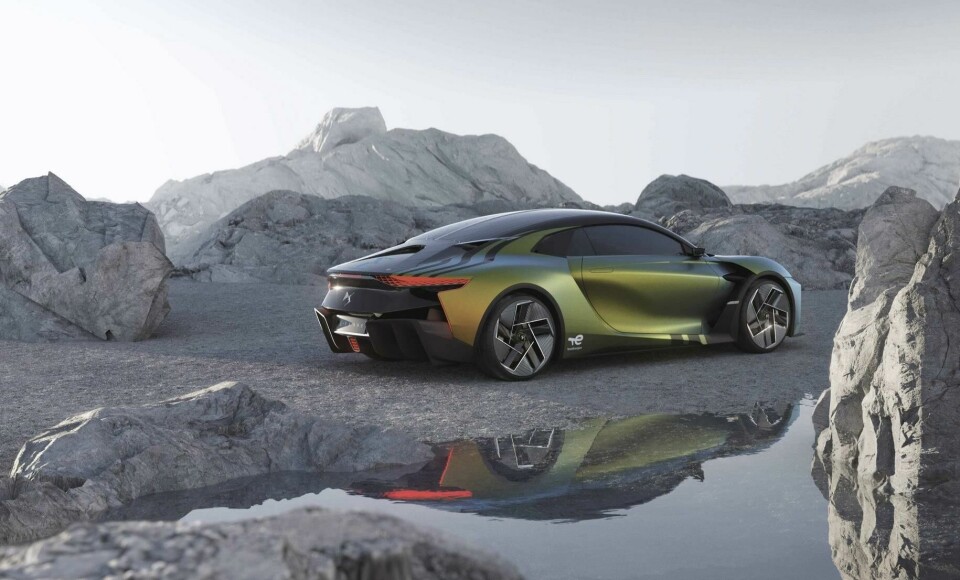
DS tests EV tech with aggressive E-Tense Performance concept
The DS E-Tense Performance concept will act as a test bed for technology that could be featured in EVs further down the line
DS has unveiled a new sporty prototype called E-Tense Performance, which marks a significant design evolution since we saw the original E-Tense concept back in 2016. The E-Tense Performance has been developed by the DS Performance team – the group responsible for the brand’s involvement in Formula E – and will be used to test technologies that could feature on future DS models.
Sitting low and close to the ground with curvy body work and broad shoulders, the E-Tense Performance looks a little Audi-esque from certain angles. Its sweeping roofline and long hood give it a striking silhouette, and at a first glance, it appears to be fairly simple in its design. However, a closer look reveals numerous distinctive details, with sharper elements contrasting with the soft curves.
At the front, the same flat rectangular surface that was featured on the DS Aero Sport Lounge sits in the centre, replacing the traditional grille and allowing for digital messages to be displayed. The images published by DS show the company’s logo on the screen, although it can also be used for other messages including a specially-designed welcome sequence.
The screen is flanked by razor-sharp boomerang lights – again similar to those on the Aero Sport Lounge. This time, though, the daytime running lamps (DRLs), which are made up of 800 LEDs, provide the only source of light, while the headlamps are replaced with two cameras. Arcing down to meet the lights and screen, the bonnet includes two large funnels to push air up and over the windscreen. The body work rises over the front wheels, emphasising the sporty look, and forms the strong shoulder line that runs the length of the car.
The wheel arches appear to be made of carbon-fibre. Vertical air outlets behind the front wheels are topped by a pointed shelf and have a lower trapezoid-shaped skirt. They are met with sculpted door panels, purposefully curved to maximise aerodynamic efficiency, before two more large intakes at the end of the door panels direct air beyond the bulging rear wheels.
The width of the car is accentuated at the rear. The chunky shoulders are outlined by the lighting signature, which again is boomerang-shaped, but also includes a new upper section consisting of small scale-like triangular patterns. These are located on a thin layer of carbon-fibre, which juts out on a small flap, and sweeps from one side of the vehicle to the other. Underneath is a single panel of body work, smooth and glossy with the DS logo at the centre. Surrounding the body panel are large spaces for air to pass freely, while an enormous diffuser dominates the lower section.
DS is yet to publish images of the interior, but the company says that the E-Tense Performance will have a cockpit designed to capture data. This will then be used to further improve the design of EV models to come. There will also be bucket seats, a black leather trim, and a Formula E-inspired steering wheel. A special sound system produced by the French company Focal will also be included.
“Our objective is to apply the experience acquired in Formula E and the expertise that we’ve taken from our international titles to a project which predicts the high-performance electric car of tomorrow,” said Thomas Chevaucher, DS Performance director. “It is a laboratory that we will use to analyse the behaviour of components and to develop them with a view to future manufacturing. The idea is also to find solutions to lower costs, make them easier to manufacture and explore implementations in production models. The next generations of the E-Tense range will benefit from these developments.”
Testing of the E-Tense Performance prototype will soon start, with Formula E champions Jean-Éric Vergne and Antonio Felix da Costa taking the wheel on private tracks before the car is then subjected to open roads. The results of these tests will likely play a crucial role in the development of DS’ new model portfolio, which will consist only of 100% pure electric models from 2024 onwards.










